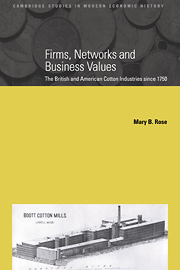Book contents
- Frontmatter
- Contents
- List of figures
- List of tables
- Acknowledgements
- 1 Introduction: the evolution of two industries
- Part I The culture of business networks 1750–1860
- 2 Industrialisation and the cotton industry in Britain and the United States
- 3 Family firms, networks and institutions to 1860
- 4 The management of labour to 1860
- 5 Networks and the evolution of government–industry relations to 1860
- Part II Continuity and change
- References
- Index
- Cambridge Studies in Modern Economic History
2 - Industrialisation and the cotton industry in Britain and the United States
Published online by Cambridge University Press: 12 September 2009
- Frontmatter
- Contents
- List of figures
- List of tables
- Acknowledgements
- 1 Introduction: the evolution of two industries
- Part I The culture of business networks 1750–1860
- 2 Industrialisation and the cotton industry in Britain and the United States
- 3 Family firms, networks and institutions to 1860
- 4 The management of labour to 1860
- 5 Networks and the evolution of government–industry relations to 1860
- Part II Continuity and change
- References
- Index
- Cambridge Studies in Modern Economic History
Summary
Textiles and industrialisation are synonymous and almost everywhere the first factories have been in the cotton industry. The position of clothing as a basic necessity, early success in mechanising textile production, and the comparative simplicity of technology, have meant that textiles in general, and the cotton industry in particular, are often the earliest industries to be modernised. Labour-rather than capital-intensive and requiring limited skill of operatives, the cotton and related textile industries suited both the resource profiles and the domestic markets of many early industrialisers and continue to do so. Similarly, textile production was developed extensively prior to modernisation in many countries. As a result basic skills became available to industrialists, even though prejudice against changing working habits might lead to significant labour market imperfections when factories and mechanisation were introduced. Moreover modest financial and technological requirements meant that relatively few barriers to entry existed until after 1960 when the industry became increasingly capital-intensive (Chandler and Tedlow 1985: 140; GATT 1984: 4; Kriedte, Medick and Schlumbohm 1982: 8; Pollard 1991: 33). These factors have meant that, whilst the cotton industry could form the basis of early spontaneous development in many countries, it has also been a prime candidate for government support as part of import substituting strategies aimed at speeding up the industrialisation process (Hoffman 1958:2–4).
The cotton industry emerged as a dominant sector in the ‘take-off’ of both Britain and the United States although the macroeconomic consequences may be unclear. The two industries shared common technological origins as new ideas on manufacturing diffused comparatively rapidly from the first industrial nation to her one-time colony.
- Type
- Chapter
- Information
- Firms, Networks and Business ValuesThe British and American Cotton Industries since 1750, pp. 21 - 57Publisher: Cambridge University PressPrint publication year: 2000



